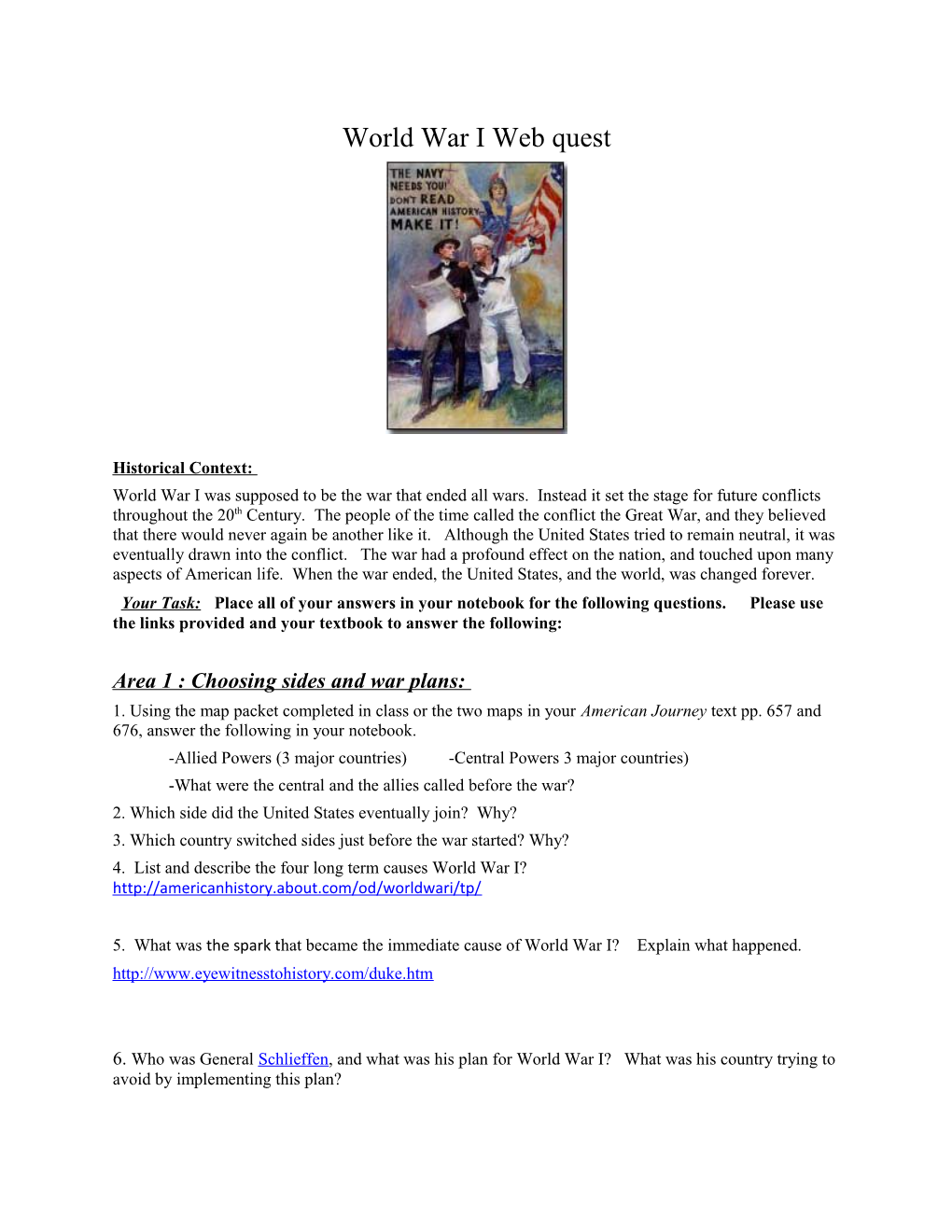World War I Web quest
Historical Context:
World War I was supposed to be the war that ended all wars. Instead it set the stage for future conflicts throughout the 20th Century. The people of the time called the conflict the Great War, and they believed that there would never again be another like it. Although the United States tried to remain neutral, it was eventually drawn into the conflict. The war had a profound effect on the nation, and touched upon many aspects of American life. When the war ended, the United States, and the world, was changed forever.
Your Task: Place all of your answers in your notebook for the following questions. Please use the links provided and your textbook to answer the following:
Area 1 : Choosing sides and war plans:
1. Using the map packet completed in class or the two maps in your American Journey text pp. 657 and 676, answer the following in your notebook.
-Allied Powers (3 major countries)-Central Powers 3 major countries)
-What were the central and the allies called before the war?
2. Which side did the United States eventually join? Why?
3. Which country switched sides just before the war started? Why?
4. List and describe the four long term causes World War I?
5. What was the spark that became the immediate cause of World War I? Explain what happened.
6. Who was General Schlieffen, and what was his plan for World War I? What was his country trying to avoid by implementing this plan?
Area 2 : Weapons of War:
1) List and describe 4 weapons introduced in World War I. Be sure to explain their effectiveness and how they were used?
2) What is Propaganda? What were four reasons propaganda posters were used?
3) What nation produced the most posters throughout WWI?
4) Go to sidebar to the right and click on a couple of countries; England, U.S. and Germany. Are they similar? List some symbols, messages, similarities and differences, if any, in the posters.
Area 3: Life in the Trenches:
1) What is trench foot? What caused trench foot?
2) What affects did it have on the body? What was the remedy for it?
3) Read the diary entries from Thomas Fredrick Littler and answer the following:
- Describe some common repetitive themes (tasks) of trench life.
- Define stalemate, How does the definition of this word describe life in the trenches?
4) What was No Man's Land? (Please be sure to describe at least three distinct features)
Area 4: America enters the War:
1) What was the Lusitania? What is the significance of the Lusitania in the War? How many people died and were there any Americans on board?
2) How many Allied and Neutral ships were lost to submarines in 1917? How many total number of Allied and Neutral ships were sunk by submarines between 1914-1918? (Scroll down...it's there!)
3) What is the Zimmerman Telegram and who wrote it? Why did Americans feel threatened by this telegram? (Think Monroe Doctrine).
4) In the telegram, what did the German government decide to begin on Feb. 1, 1917? What was promised to Mexico in the telegram?
5) When does the Untied States declare war on Germany? Who was John J. Pershing?
6) What was the Brest-Litovsk Treaty? How did it affect the fighting on the Western Front? (Think Schlieffen Plan)
Area 5: Results of the War:
1) What was the name of President Wilson’s on January 8, 1918?
2) Through the points mentioned in the above article, how does Wilson address:
- Imperialism
- Militarism
- Navigation of the seas
- International trade
- Self-determination What does this mean?
- League of Nations
3) How does the US Congress feel about the League of Nations? Why is this League set up for failure?
4) In Articles 231&232 of the Treaty of Versailles, what is Germany responsible for?
5) What happened to most of Wilson's Points in the final draft of the Treaty of Versailles? Why?
6) What country lost the most soldiers, and has the most missing, How many American soldiers died and what was the total number of soldiers who died in the war?
7) When did the war end? When was the Treaty of Versailles signed? Why are these dates significant?
8) Why did this attitude of an unfair peace and US noninvolvement in the League of Nations help set up the foundations for a new world conflict?
Reflection Assignment
Historical Context:
World War I was supposed to be the war that ended all wars. Instead it set the stage for future conflicts throughout the 20th Century. The people of the time called the conflict the Great War, and they believed that there would never again be another like it. Although the United States tried to remain neutral, it was eventually drawn into the conflict. The war had a profound effect on the nation, and touched upon many aspects of American life. When the war ended, the United States, and the world, was changed forever.
Using the information acquired from your Webquest, write a well-constructed essay including the following:
- An Introduction, body and conclusion.
- Evidence of proof reading—grammar and spelling do not interfere with the message.
- Answer a separate sheet of paper to be used as a rough draft for your next test.
-List and describe the long and short-term causes of World War I. Be sure to also include how the agreements at the Treaty of Versailles left many of the causes still in place after the war.
-Be sure to use specific examples from your World War I Webquest as well as other information provided in class.
-Be sure your thesis is supported through the body and conclusion from this packet and other information from this unit.
-Be sure the essay has clarity and answers the question.
